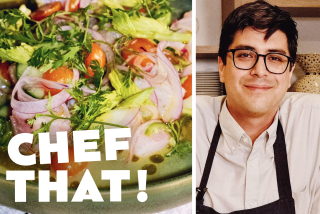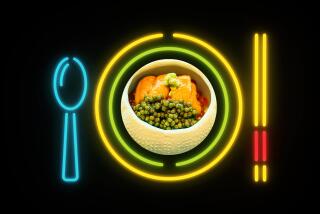Chengdu Taste’s secret-menu item — lion fish — is a rare find
- Share via
When my friends Margy Rochlin and Anne Fishbein traveled to China with a delegation of women chefs a dozen years ago, they visited cooking school after cooking school to witness the progress that was being made in provincial Chinese kitchens. And in the article they produced for Gourmet, something they saw demonstrated everywhere, but especially in the Sichuan capital Chengdu, was a dish usually translated as “lion fish,” an ordinary fish whose flesh was flayed in an intricate manner before being dusted with cornstarch and deep-fried.
The lion fish, so called because its carved meat flowed backward from the head like streamers from the kind of dancing-lion masks you see in Chinese New Year parades, was about 90 percent crunch, but seemed to exist primarily to display the dexterity of the student chefs. It is difficult to lift the filet from the bone in a single piece, cut it into curling ribbons, and excise annoying bits of fin and gill without separating the meat from the head. The finished fish had to be crunchy but not overdone, glazed with just enough sweet sauce, and positioned on the plate with a pleasing arc to its spine.
Everything is exposed — if the chef leaves too much meat on the frame, accidentally severs a section of filet, or lets the fish fry in an awkward position, everybody knows, and while the dish may be perfectly edible, it is not fit to be served. While I’m sure lion fish has a respectable place on the Chinese banquet table, I always suspected it was a dish that existed so that student chefs could learn how to make it, like the school figures that used to count so heavily in the scores of Olympic figure skaters, or the triple consommés that American chefs learn how to make in cooking school and then never come near again. I’ve never seen lion fish on a menu.
But when I was at the Monterey Park Sichuan restaurant Chengdu Taste the other night, enjoying numb-taste wonton and younger sister’s rabbit with a group that happened to include Rochlin and Fishbein, I noticed an odd dish sailing over our heads to a table in the corner. One of us asked what it was. Somebody else asked if there were any left. And a few minutes later, a huge tilapia made its way onto our table, a creation that looked like a huge, golden, abstracted rib cage attached to a sullen fish head, like a Bloomin’ Onion of the undersea world, in a shallow puddle of sweet, spicy sauce. Lion fish.
The chef wanted to display all the flavors of the Chengdu kitchen, the waiter explained, not just the fiery-hot preparations everybody associates with the region (and with the restaurant), but the entire range of sensations that people in Chengdu enjoy every day.
I was thrilled to experience this dish that Rochlin had been talking about for years. And while it is not quite my favorite seafood at Chengdu Taste — that would have to be either the filet with red chile oil and tofu pudding or the transcendent water-boiled fish with green pepper — it was very good, crunchy but with a jerky-like chewiness, just touched with vinegar, and festive enough for a party.
Lion fish isn’t on the menu yet, but you can probably reserve one if you call ahead. Note: Chengdu Taste is one of the most wildly popular restaurants in the San Gabriel Valley. Go right when it opens at 5 p.m. or be prepared to wait for hours.
828 W Valley Blvd, Alhambra, (626) 588-2284.
ALSO:
Jonathan Gold reviews Chengdu Taste
Favorite sushi bars from Jonathan Gold
Where to take the chefs from Hong Kong who want dim sum?
More to Read
Eat your way across L.A.
Get our weekly Tasting Notes newsletter for reviews, news and more.
You may occasionally receive promotional content from the Los Angeles Times.











